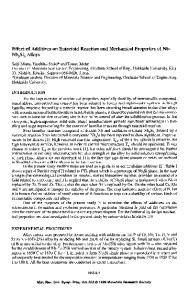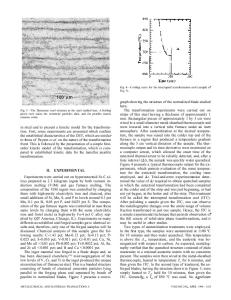Effect of prestrain on the mechanical properties of eutectoid steel
- PDF / 3,894,965 Bytes
- 10 Pages / 603.28 x 788 pts Page_size
- 32 Downloads / 351 Views
I.
INTRODUCTION
THErailroad industry is under acute demands to meet the requirements of the increasing carrying capacity of railroad freight cars, and consequently the rate of increase of freight car capacity has shown quite an acceleration in the past 15 years, ~particularly due to the introduction of the 125-ton capacity freight car in 1964 and its subsequent approval as an Association of American Railroad design. 2 The higher train speeds and maximum train length (70 cars) 3 can each contribute to more severe demands placed on both wheels and track. The serviceability of the rail is directly related to how well it resists structural failure and wear. Often a serious threat to the structural integrity of rail, excessive wear is, in fact, the primary reason for removal from service. Wear limits have been selected in an attempt to decrease the risk of fracture, loss of gage control, and excessive dynamic loads, all possible consequences of excessive wear. Service records commonly report the results of an apparent trade-off between wear resistance, strength, and fracture resistance, each controlled by separate microstructural features, alloying elements, and heat treatment. For example, strength and hardness can directly affect the long-term behavior of the raiP since rail materials of relatively low strength and hardness have a tendency to work harden to a greater degree than high strength and hardness material, producing a relatively thick work-hardened layer and thus large flakes and shellings.* *Flakes are surface cracks which initiate at or near the gage comer surface, grow into the rail head to a depth of up to 2 mm below the running surface, and eventually cause thin sections of material to spall off. Shellings or shelly cracks nucleate at a depth of 5 to 7 mm below the gage corner rails from both sulfide and silicate inclusions. The cracks grow longitudinally at an angle of 30 to 40 deg with the running surface and may run within the railhead for a distance of up to 1 m before breaking out. 4
In order to relate such service conditions to changes in metallurgical parameters, plain carbon eutectoid rail steel, which exhibits low strength and hardness compared to high strength alloy rails, was used to investigate how deformation due to wear and temperature affect the impact resistance and dynamic fracture toughness of fully pearlitic rail steel.
II.
EXPERIMENTAL PROCEDURE
A. Material
The material used in this investigation is 1080 steel, in the form of standard rail stock supplied by the Association of American Railroads in a fully pearlitic microstructural condition. All specimens were cut from a section of rail of the following composition: C 0.80 wt pct Si 0.170 Mn 0.84 S 0.013 P 0.018 Fe bal. Standard ASTM Charpy 5 and tensile blanks were cut from the rail head, as shown in Figure 1. This orientation was chosen to simulate a transverse defect in the rail head which commonly results in catastrophic failure. These failures, known in the rail industry as "detail fractures", are the result of thumbnail c
Data Loading...











